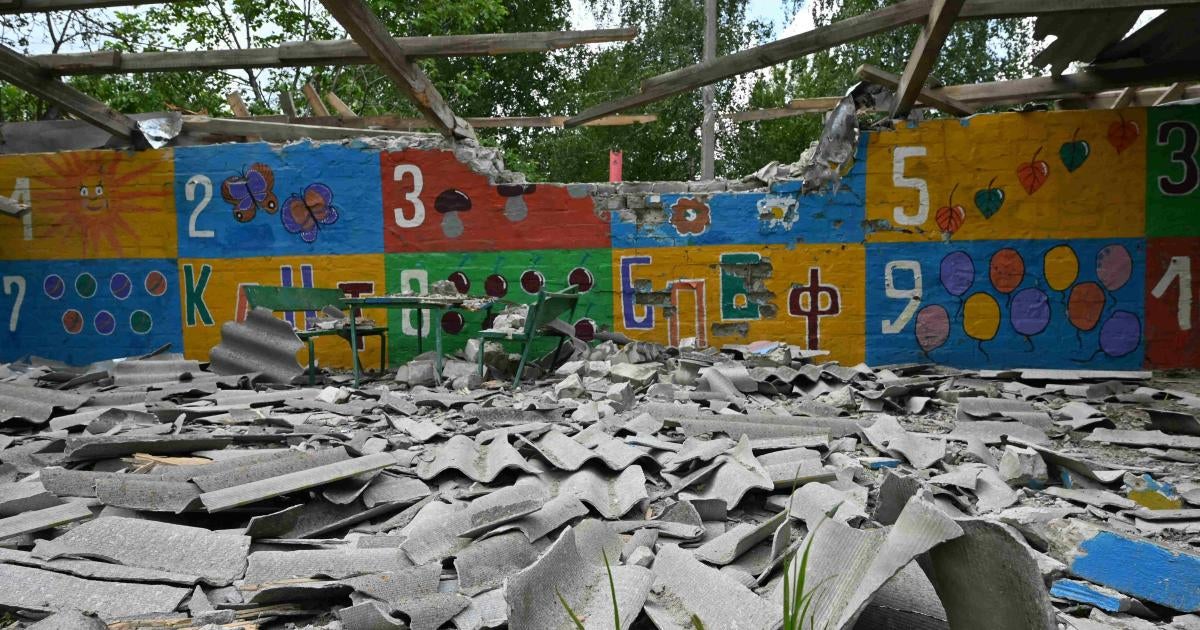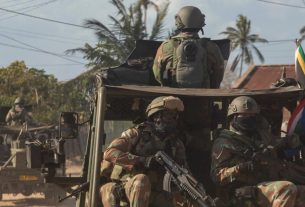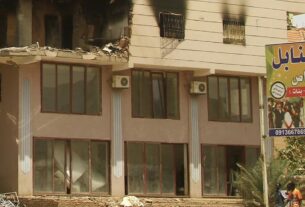- Russia’s full-scale invasion of Ukraine has devastated schools and kindergartens throughout the country. Since February 2022, over 3,790 educational facilities have been damaged or destroyed.
- Ukrainian children have paid a high price in this war because attacks on education are attacks on their future.
- International donors and aid agencies should support the Ukrainian government to ensure the equitable reconstruction of schools in all regions of Ukraine.
(Kyiv, November 9, 2023) – Russia’s full-scale invasion of Ukraine has devastated schools and kindergartens throughout the country, Human Rights Watch said in a report and video released today. Since February 2022, over 3,790 educational facilities have been damaged or destroyed, according to Ukrainian government figures, severely interrupting access to education for millions of children.
The 71-page report, “Tanks on the Playground,” documents the damage and destruction of schools and kindergartens in four Ukrainian regions during the first months of the fighting. Most of the damage to educational facilities resulted from aerial attacks, artillery shelling, rocket strikes, and, in some cases, attacks using cluster munitions – causing significant damage to roofs, the collapse of walls, and major debris in classrooms. Russian forces frequently looted and pillaged schools they occupied, a war crime.
“Ukrainian children have paid a high price in this war because attacks on education are attacks on their future,” said Hugh Williamson, director of the Europe and Central Asia division at Human Rights Watch. “The international community should condemn the damage and destruction of schools in Ukraine and looting by Russian forces.”
Human Rights Watch visited 50 education facilities in the Kyivska, Kharkivska, Chernihivska, and Mykolaivska regions and interviewed almost 90 school officials, representatives of local authorities, and witnesses to military operations.
Education in Ukraine has been under attack since Russia first invaded Ukraine in 2014. Russia’s full-scale invasion in 2022 led to further attacks on and military use of schools, which, along with the overall effects of war, have severely disrupted Ukrainian children’s education, already suffering from school closures due to the Covid-19 pandemic. Many students from schools that were damaged or destroyed had to continue their studies in other schools, studying in shifts or remotely, which has eroded the quality of education, Human Rights Watch said. Russian forces’ attacks on power infrastructure and consequent electricity and internet outages have frequently impeded remote learning.
The Ukrainian government has taken several key steps to protect education from attack. In 2019, Ukraine endorsed the Safe Schools Declaration, an international political commitment that aims to protect education from the worst effects of armed conflict. In August 2021, Ukraine adopted an action plan to carry out to the declaration’s requirements. As of January 2022, one thousand Ukrainian military officials had been trained in the Safe Schools Declaration and the Declaration’s “Guidelines for Protecting Schools and Universities from Military Use during Armed Conflict.”
In July 2022, Ukrainian authorities also issued a high-level military order aiming to “non-use … premises of educational facilities for the temporary accommodation of military headquarters and units,” according to Ukraine’s Defense Ministry.
The damage and destruction of schools that Human Rights Watch documented typically occurred when Russian forces captured cities and towns and occupied schools during the early weeks of the fighting in 2022. In several cases, Russian forces fired on the schools they had used as they withdrew from areas they had occupied, further damaging them.
When occupying schools, Russian forces pillaged them, looting desktop and laptop computers, televisions, interactive whiteboards, other school equipment, and heating systems. What was not stolen was often broken. Upon withdrawal, Russian forces left behind burned-out and ransacked classrooms. They also painted graffiti on walls, typically expressing hate toward Ukrainians.
For example, Russian soldiers occupied Borodianska school in the Kyivska region and used it for military operations against Ukrainian forces. The school was badly damaged by Ukrainian return fire. Russian soldiers left anti-Ukrainian graffiti and a flag with a Nazi swastika on classroom walls.
“It was impossible to hold back tears,” the school’s director said. “In the cafeteria, they [Russian forces] set up a bath [in the sink]. In another room there was blood on the walls. … They broke all the computers… and filled everything with dirt. … They simply stole the laptops.”
Using schools as living quarters for troops, storing ammunition, or parking or deploying military vehicles on school grounds makes attacks on schools more likely. Military forces are obligated under the laws of war to do everything feasible to protect schools and other civilian objects under their control from the effects of attack.
Previous Human Rights Watch reporting documented how Russian forces attacked schools and kindergartens, including schools for children with disabilities; tortured, raped, and otherwise ill-treated prisoners-of-war and detained civilians in schools; and used schools to detain civilians.
Russia has not endorsed the Safe Schools Declaration. The United Nations and others should press the Russian government to immediately cease deliberate, indiscriminate, and disproportionate attacks against civilians and civilian objects, including schools, and urge Russia to avoid using Ukrainian educational facilities for military purposes. Russia should carry out the declaration’s provisions and include its principles in training military personnel.
In a few cases Human Rights Watch documented, Ukrainian forces placed soldiers in schools, set up checkpoints near school buildings, or deployed small numbers of Territorial Defense Forces’ members to provide security for civilians sheltering in schools, actions that can increase the risk of attacks.
The Education Ministry reported that over 95 percent of eligible students were enrolled in schools as of January, a significant achievement during wartime, Human Rights Watch said. Despite these efforts, interrupted learning due to the war, and global evidence from the coronavirus pandemic that switching from in-person to remote education often causes learning losses and inequality, indicate the massive effort needed to help Ukrainian children recover their education.
A woman living in Izium, in the Kharkivska region, told Human Rights Watch that she struggled with remote learning for her 14-year-old son. “There is no internet, so no video lessons,” she said. “You can’t just [convey tasks to teachers] by phone, you need a laptop. He can’t set up the virtual classroom on his phone.”
Being able to return children to classrooms adds urgency for Ukraine, with the support of international partners, to restore and reconstruct damaged educational facilities in line with safety and accessibility standards, Human Rights Watch said.
International donors and humanitarian agencies should support the Ukrainian government to ensure the equitable reconstruction of schools in all regions of Ukraine and require strict adherence to accessibility standards mandatory under Ukrainian law.
“Most countries around the world, including European Union and NATO members, have pledged to protect education from attack, and they should help Ukraine achieve that goal,” Williamson said. “Ukraine’s children have the same right to education as children everywhere, and despite the war this crucial right should be protected.”



